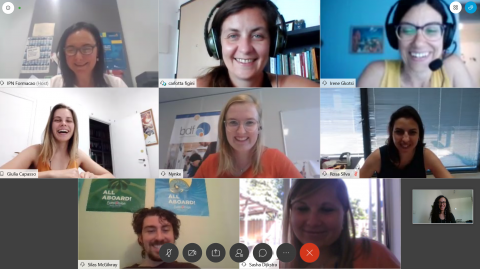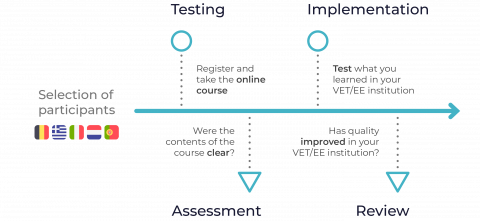3.1 - Design the links with and engage the external collaborator
Abstract
To enhance the quality of education and make your VET institution a dynamic educational
environment, it is important to design links with external collaborators, but also to engage them in
your educational practices. As Quality Manager, you should be aware that, for VET providers,
cooperation with external stakeholders and in particular the world of work is a key activity with
many different benefits for the quality of the training.
Why is this important for you as a QM?
- To enhance the quality of education by improving the overall quality of the training;
- To be updated on what is really needed for the learners’ employability;
- To make sure the students are in a dynamic educational environment;
- To create more impact in your VET institution with more external knowledge and expertise;
- To obtain valuable information from the start-ups, enterprises, etc. for their sectors in relation to what is needed (knowledge skills, competences, etc.) from future graduates and thus, to adapt the training to the actual needs of the job market;
- To improve specifically the organisation of work-based learning, which is a fundamental element for VET Providers, thanks to the development of close relationships with the work environment. The work-based training/internships will be arranged easier with the available external links.
How should I implement the action?
- Identify the most important external stakeholders for your VET institution;
- Establish contacts in order to recruit enterprises to cooperate with the VET provider in terms of definition of the skills and competences needed, the contents of the Training Courses, and to provide appropriate work-based learning opportunities. This is usually a long-term endeavour that calls for continuity, networking and establishment of dependable partnerships
- Create invitations to company representatives to events, such as presentations of students’ work to the public
- Organize visits to companies with the students
- Make use of focus groups, where your VET institution is represented as well as its external connections;
- Try to make connections with the employers of your VET institution’s graduates and ask them to evaluate the work of these graduates;
- Be in contact with employers’ associations and chambers in order to ensure mutually- beneficial collaboration with other companies/organisations;
- Make connections with secondary schools to recruit future students easier;
- Invite companies to implement joint projects
- After establishing the connections with other VET institutions, set up a partnership agreement for you and all those VET institutions;
- Actively engage the external collaborators continuously
- Develop the training plan together and constantly
- Keep the flow of communication running in order to be able to immediately receive feedback
- Invite the stakeholders to take part in surveys or interviews on the entrepreneurship education training offer
- Make sure there is also transnational cooperation (study visits, conferences, joint projects, mobility of teachers and students.
How should I know if I have made an impact thus increasing the quality of the VET provision and to which extent? (Indicators also linked with the EQAVET if any):
If your VET institution has no problem contacting an external collaborator when needed;
● If your VET institution can arrange work-based training and internships easily;
● If your VET institution collaborates with other VET institutions;
● If there is good communication with external collaborators;
● If the number of activities with the external collaborators is sufficient;
● If the external collaborators are active in their participation;
● If you can exchange internal quality management practices with other VET institutions for
improved quality management;
● If the participation rate in your VET programmes increases by 10%, impacted by the benefits
obtained through collaborations with external organisations, as measured by the EQAVET
Indicator n.3;
● If the completion rate in VET programme increases by 10% because your external collaborator
connections provide for enough work-based training and internship placements for example,
as measured by the EQAVET Indicator n.4;
● If the placement rate in VET programmes has increased by 10% due to links with external
collaborators, which contribute to work-based training/internships and overall familiarity with
possible external collaborators, as measured by the EQAVET Indicator n.5;
● If the unemployment rate according to individual criteria has decreased by 10%, which could
be a consequence of appropriate work-based training/internship placements (which could
lead to future job opportunities) and overall familiarity with possible companies that could be
potential employers, as measured by the EQAVET Indicator n.7
● If the success rate of disadvantaged groups according to age and gender has risen by 10% due
to proper connections with external collaborators, as measured by the EQAVET Indicator n.8
● If the training needs in the labour market are identified, which can be done by having SMEs
and other external companies as connections, as measured by the EQAVET Indicator n.9
Links & further readings (includes also third-party resources- videos, etc.):
- IN-QUAL project’s Common Reference Framework, paragraphs:
- 1.1.1. Methodology for internal evaluation
- 1.2.1 EQAVET toolkits & tools
- 1.2.2 Other existing toolkits & tools
- Cedefop (2015). Supporting internal quality management and quality culture. Luxembourg: Publications Office of the European Union. Cedefop Reference series; No 99.
- Cedefop 2015, Handbook for VET providers [https://www.cedefop.europa.eu/files/3068_en.pdf]
- (Last accessed 30/03/2020)
- Cedefop (2015). Work-based learning in continuing vocational education and training: policies and practices in Europe. Luxembourg: Publications Office of the European Union. Cedefop research paper; No 49 https://www.cedefop.europa.eu/en/publications-and-resources/publications/5549 Last accessed 30/03/2020



